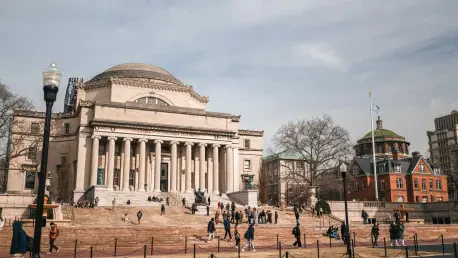As the financial landscape of higher education continues to evolve, few institutions have faced challenges as complex as Columbia University in fiscal year 2025. To unpack these issues, we’re thrilled to speak with Camille Faivre, a renowned education management expert with a deep focus on institutional strategy and innovation. With her extensive experience in guiding universities through turbulent times, particularly in the post-pandemic era with an emphasis on open and e-learning programs, Camille offers a unique perspective on Columbia’s financial struggles, the impact of political decisions, and the university’s path forward. In this conversation, we dive into the sharp decline in Columbia’s operating surplus, the effects of federal funding cuts, and the strategic measures taken to stabilize research and operations amidst rising costs.
Can you walk us through the reasons behind Columbia University’s operating surplus dropping by over 63% in fiscal year 2025?
Certainly. The dramatic decline to $112.6 million in operating surplus was primarily driven by a mismatch between revenue growth and escalating expenses. Revenues grew by just 2.1%, while expenses surged by 5.3%, reaching $6.6 billion. This imbalance reflects broader trends in higher education where costs—whether for salaries, research, or facilities—often outpace income from tuition or grants. At Columbia, the strain was particularly acute due to external pressures like flat federal grant revenue, which stayed at $1.3 billion, and internal cost increases across nearly every category. It’s a stark reminder of how vulnerable even well-endowed institutions can be to economic and political shifts.
How significant was the role of rising operating expenses in this financial downturn compared to the slower growth in revenue?
The rise in operating expenses was the heavier burden here. That 5.3% increase in costs—covering everything from instructor pay to maintenance—far outstripped the modest 2.1% revenue bump. While tuition and fees did grow by 4.1% to $1.6 billion, this was tempered by a 4.6% increase in financial aid, which hit $622.6 million. Essentially, the university’s commitments to accessibility and operational needs ate into any potential gains. This kind of cost-revenue disparity is a growing challenge for elite institutions like Columbia, where maintaining excellence often means spending more than you’re bringing in.
What impact did political actions, particularly from the Trump administration, have on Columbia’s finances during this period?
The political landscape was a major disruptor. In March of fiscal 2025, the Trump administration terminated $400 million in federal grants and contracts, citing allegations around the university’s handling of antisemitism issues. This wasn’t just a financial hit; it was described as ‘destabilizing’ by Columbia’s leadership. The cuts directly affected research programs and led to layoffs of nearly 180 employees tied to those federally funded projects. It created a ripple effect, undermining confidence and straining operations in ways that the year-end financial statements couldn’t fully capture.
Can you elaborate on how Columbia responded to the immediate fallout from these federal funding cuts?
Columbia took swift, albeit painful, steps to manage the crisis. The layoffs were a tough but necessary measure to align with the sudden loss of funding. Beyond that, they tapped into unrestricted endowment funds to create a Research Stabilization Fund. This initiative was critical in preserving some research projects that would’ve otherwise collapsed. By issuing around 500 internal grants in June and September, even if on a modest scale, the university signaled a commitment to its research mission despite the external shocks. It was a stopgap, but an important one.
What can you tell us about the agreement Columbia reached with the Trump administration to reinstate some of the canceled grants?
In July, just after the fiscal year closed, Columbia signed a formal agreement to restore most of the terminated research grants. However, it came with heavy conditions. The university agreed to a $200 million payment to the government, spread over three years, which is a significant financial burden that will impact long-term planning. Additionally, there was a $21 million allocation for a claims fund tied to an agreement with the U.S. Equal Employment Opportunity Commission. These terms, while securing some stability for research, reflect the kind of unprecedented political leverage that can reshape an institution’s financial priorities.
How are rising costs across various areas affecting Columbia’s ability to maintain its academic and operational standards?
The 5.3% spike in expenses to $6.6 billion touched every corner of the university—salaries for faculty and staff, research investments, and even basic maintenance. When costs rise at more than double the rate of revenue, as they did at Columbia, it squeezes the budget for discretionary spending on innovation or student services. Yet, Columbia’s leadership has emphasized cost containment to preserve flexibility. They’re walking a tightrope, balancing the need for excellence in teaching and research with the reality of financial constraints, which is a challenge many universities face but few at this scale.
What does the creation of the Research Stabilization Fund reveal about Columbia’s priorities and long-term strategy?
The Research Stabilization Fund is a clear statement of Columbia’s commitment to its research enterprise, even under duress. By drawing from unrestricted endowment funds, they’ve prioritized continuity for researchers through those 500 internal grants. It’s a modest effort in terms of total funding, but it’s strategic—keeping projects alive buys time for alternative funding or political resolutions. Long-term, it shows they’re willing to invest in their core mission, even if it means dipping into reserves, which could set a precedent for how they handle future crises.
What is your forecast for the financial stability of elite universities like Columbia in the coming years, given these kinds of political and economic pressures?
Looking ahead, I think elite universities like Columbia will face a dual challenge: navigating unpredictable political interventions and managing structural cost increases. Federal funding, which is a lifeline for research, could remain volatile if political tensions persist. At the same time, the pressure to keep tuition affordable while covering rising expenses will test their financial models. My forecast is cautiously optimistic—Columbia’s $20.5 billion in net assets and $10.9 billion endowment provide a buffer, but they’ll need innovative strategies, like diversifying revenue or enhancing digital learning platforms, to stay resilient. Adaptability will be key.








